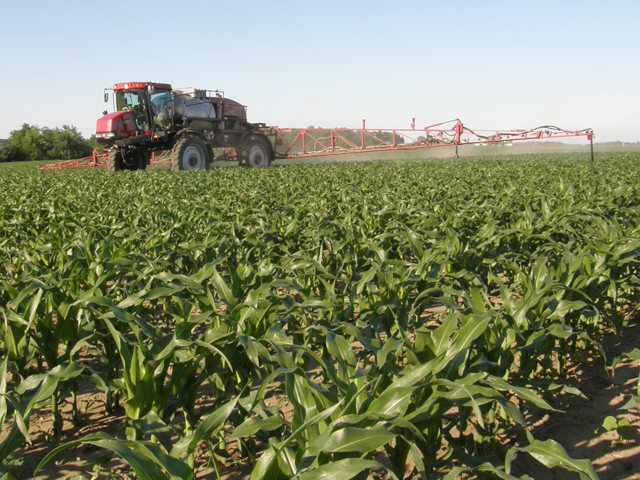Corn Growers Set Sustainability Goals
NCGA Goals Include Reducing Greenhouse Gas Emissions 13% by 2030
LINCOLN, Neb. (DTN) -- As the Biden administration focuses on carbon reduction in all segments of the economy, the National Corn Growers Association this week announced a number of sustainability goals it wants to see corn farmers in the United States achieve by 2030.
NCGA said in a sustainability report released on Monday that while farmers have become more sustainable in their operations since 1980, there is room to improve crop-production practices.
NCGA set goals for improving sustainability in corn production by 2030. That includes increasing land-use efficiency by 12%, reducing soil erosion 13%, increasing water-use efficiency by 15%, increasing energy-use efficiency by 13% and reducing greenhouse gas emissions by 13%.
"The truth is that we have a great story to tell," NCGA President and Ohio farmer John Linder said during a Zoom call on Monday.
"We have decades of documented improvements on our side, which happened long before sustainability became a part of our daily vocabulary in 2019."
The report said from 1980 to 2015, corn farmers decreased acres planted by 41%, reduced soil loss per acre by 58%, decreased water use 46%, improved energy use in producing corn by 41% and reduced greenhouse gas emissions by 31%.
NCGA recently formed a corn-sustainability advisory group made up largely of corn farmers. The group spent the past 18 months conducting the sustainability study. Linder said the group will review the goals in 10 years and "adjust if needed."
For generations, farmers have voluntarily implemented conservation practices to improve efficiencies, but those practices can be costly and may show little return early on.
IMPLEMENTING PRACTICES
The new NCGA sustainability goals come at a time when crop-input prices are high, and questions remain about how much money will be available for federal conservation and other crop programs.
P[L1] D[0x0] M[300x250] OOP[F] ADUNIT[] T[]
Linder said when he launched into implementing conservation practices on his Edison, Ohio, farm nearly 30 years ago, he did so on his own dime.
"When we were looking at our land and thinking about implementing practices in 1985, when we adopted no-till, I can tell you the first four years the economic return wasn't exactly predictable," he said.
"Man, I wish someone would have said 'Hey, I'm gonna supplement you for four years while you figure out how you can no-till corn.' But we didn't have that ability, and so those opportunities are very welcome and may be much needed because cost of inputs today are exponentially higher than they were back then."
While crop insurance and conservation programs are needed, Linder said, farmers want to improve their operations by having expanded market opportunities.
"We need those conservation programs, and we need price support when it's appropriate," he said.
"We don't need carte blanche. We don't want to go make our living going to the mailbox getting another government check. We want to derive it from the marketplace. Farmers are really telling me every day -- and have been for years -- 'I want to make my living in the marketplace, but when you buy retail and sell wholesale, it becomes a challenge, so all these tools are critical."
Shelton, Nebraska, farmer and NCGA board member Deb Gangwish, said she believes the industry may meet the sustainability goals early.
"Just everyone that I know in agriculture, they've implemented some sustainable strategies and practices," she said. "That's one of the key elements highlighted in our sustainability report is showcasing all those efforts, there's great efforts that are already underway. We've done a lot of things, and farmers just don't talk about it. So, we're kind of tooting our own horn here as far as what we've done really well and how we have that deep desire to continue to do well.
"We want our farms to go forward into the future. There's not a farmer I've talked to that doesn't have that in their heart. Setting goals puts a stake in the ground for where we want to go and allows us to measure progress."
Gangwish said her family farms 100% irrigated corn on about 8,000 acres in central Nebraska atop the Ogallala Aquifer. So, the farm has implemented a number of practices to monitor water usage.
"There's a lot of different things that we do, including telemetry on all of our pivots," she said, "so we're able to remote in from our phone and take a look at how the pivot's running, if anything's going wrong. We also work with electric companies to share the load. It's called load control. So, typically, in high-energy load times, our pivots will be turned off."
The farm also uses weather stations to make sure irrigation isn't happening when it's not needed.
"Irrigation technology has advanced substantially," Gangwish said.
"And I see more and more farmers around us continuing to adopt various technologies so they can raise their corn crop more efficiently each year."
Read the sustainability report here: https://dt176nijwh14e.cloudfront.net/….
Todd Neeley can be reached at todd.neeley@dtn.com
Follow him on Twitter @DTNeeley
(c) Copyright 2021 DTN, LLC. All rights reserved.






